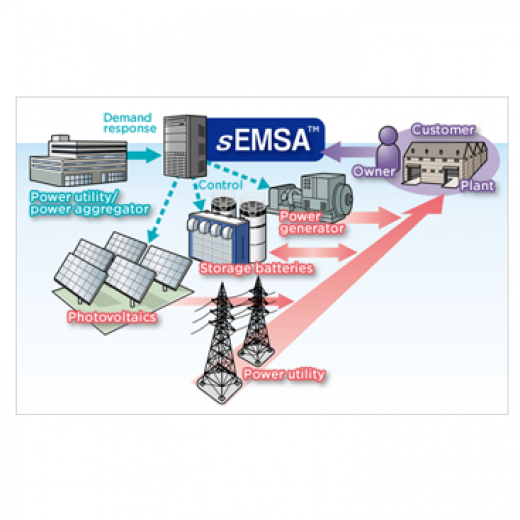
Energy Management System Architecture (sEMSA™)
Energy Management System Architecture (sEMSA™)
The sEMSA™ is an energy management system with an original architecture. With the increasing use of distributed energy sources such as photovoltaic power generation, cogeneration systems, and storage batteries, this system can be used to control different resources and reduce electricity costs. The sEMSA™ enables an aggregator, such as an electric power service provider, to build a system that bundles demand and to collectively manage energy resources and adjust power supply with demand response, thereby obtaining economic benefits.
Product features

Product features

-
As it can be used with any type of equipment, this system can swiftly and wisely control different types of energy sources such as renewable energy systems, generators, or storage batteries without the need for manpower.
-
Based on actual past data, the system is able to predict electric power demand, draft a plan for optimal operation of each equipment unit, and provide control in real time.
-
With Open ADR 2.0, the system is able to provide a fully automated demand response.
Product applications
1. Plant energy management system
While monitoring the plant’s electric power load, the system automatically optimizes the operation of electric power generation, including renewable energy and storage batteries, reducing electricity costs.
2. Demand response solution
At times of peak power demand, a demand response signal is received from the electric power provider. sEMSA™ receives this signal through the aggregator and automatically controls the storage batteries, generator, etc. to reduce power consumption.
1. Plant energy management system
While monitoring the plant’s electric power load, the system automatically optimizes the operation of electric power generation, including renewable energy and storage batteries, reducing electricity costs.
2. Demand response solution
At times of peak power demand, a demand response signal is received from the electric power provider. sEMSA™ receives this signal through the aggregator and automatically controls the storage batteries, generator, etc. to reduce power consumption.
Product types and specifications
While the system can be applied to almost all standard electric power components used in small and medium plants, it is also possible to expand the specifications for use in large plants. For the verification phase before systemization of demand response control, expanded functions are used in the same way.
Equipment components that can apply sEMSA--Standard specifications and expanded specifications
| Applicable equipment | Type of equipment | Maximum number of units | Maximum power output | Remarks |
|---|---|---|---|---|
| Generator | Gas engine | 1 (can be expanded up to 6) | 4000 kW / machine | Waste heat utilization is handled individually for each project. |
| Gas turbine | ||||
| Diesel engine | ||||
| Micro-cogenerator | ||||
| Photovoltaic generator | Can be used with any equipment | 1*1 (can be expanded up to 16) | 4000 kW / machine | - |
| Storage battery | RF battery | 1*2 (up to 3 with expanded specifications) | ±2000 kW / battery | - |
| Li-ion battery | ||||
| Lead storage battery |
*1 The arbitrary pieces combination is counted as one unit.
*2 Each pieces counts as one unit.
